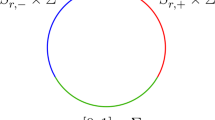Summary
SU 3 is derived from dual models using a smaller number of assumptions than is used in other works. The paper is divided into two parts. In the first partSU 2 andSU 3 dynamics are derived from realistic 5-point functions. TheSU 3 particle spectrum, however, has been put in by assuming the mesons to consist of quark-antiquark pairs. In the second part of the workSU n is derived from the generalized Veneziano model (four-point function with excited legs) using an algebraic method. Duality is shown to be equivalent with the associativity of a certain algebra.
Riassunto
Si deduceSU 3 dai modelli duali usando un minor numero di ipotesi di quante ne sono usate in altri articoli. L’articolo è diviso in due parti. Nella prima parte si deduce la dinamica diSU 2 eSU 3 da funzioni di 5 punti realistiche. Tuttavia si è introdotto lo spettro delle particelle diSU 3 supponendo che i mesoni consistano di coppie quark-antiquark. Nella seconda parte dell’articolo si deduceSU n dal modello di Veneziano generalizzato (funzione di 4 punti con estremità eccitate) usando un metodo algebrico. Si dimostra che la dualità è equivalente all’associatività di una certa algebra.
Реэюме
Испольэуя меньщее число предположений, чем зто делается в других работах, выводитсяSU 3 иэ дуальных моделей. Работа состоит иэ двух частей. В первой частиSU 2 иSU 3 динамика выводится иэ реалистичных пятиточечных функций. Однако спектр частицSU 3 вводится с помошью предположения, что меэоны состоят иэ пар кварк-антикварк. Во второй части работы, испольэуя алгебраический метод, выводитсяSU n иэ обобшенной модели Венециано (четырехточечная функция с воэбужденными концами). Покаэывается, что дуальность зквивалентна ассоциативности некоторой алгебры.
Similar content being viewed by others
References
C. Lovelace:Phys. Lett.,28 B, 265 (1968).
G. P. Canning:Nucl. Phys.,14 B, 437 (1969).
S. Mandelstam:Phys. Rev.,184, 1625 (1969).
J. Dethlefsen: Copenhagen preprint P 701 (1970).
C. A. Savoy:Lett. Nuovo Cimento,2, 870 (1969).
K. Bardakçi andH. Ruegg:Phys. Lett.,28 B, 671 (1969);J. E. Paton andChan Hong-Mo:Nucl. Phys.,10 B, 516 (1969).
V. A. Alessandrini, D. Amati, M. Le Bellac andD. I. Olive:Phys. Rep.,1 C, No. 6 (1971).
C. M. Andersen andJ. Yellin:Phys. Rev. D,3, 846 (1971);R. Capps:Phys. Rev. D,3, 3059 (1971);Phys. Rev. Lett.,10, 312 (1963).
R. E. Cutkosky:Phys. Rev.,131, 1888 (1963).
M. A. Neumark:Normierte Algebraen (Berlin, 1959).
I. N. Herstein:Noncommutative Rings, Carus Math. Monographs (1968), p. 48;J. H. M. Wedderburn:Ann. of Math.,38, 854 (1937);Proc. London Math. Soc.,6, 77 (1908).
Author information
Authors and Affiliations
Rights and permissions
About this article
Cite this article
Dethlefsen, J.M., Nielsen, H.B. Derivation ofSU 3 from dual models. Nuov Cim A 14, 85–102 (1973). https://doi.org/10.1007/BF02734605
Received:
Revised:
Published:
Issue Date:
DOI: https://doi.org/10.1007/BF02734605




